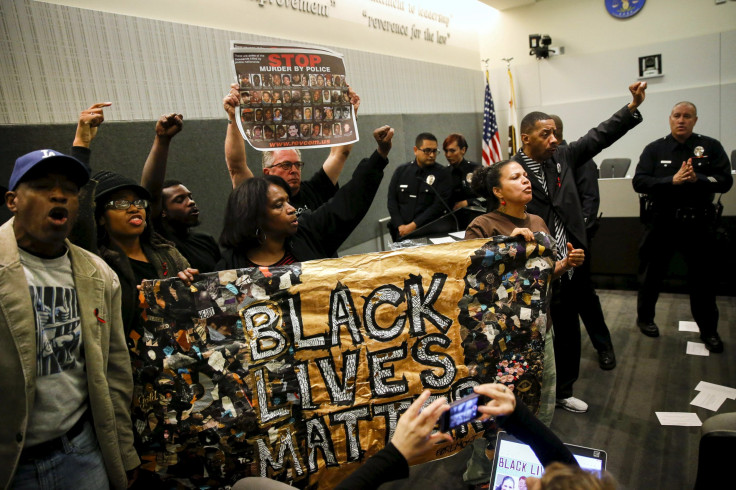Rachel Dolezal Media Circus: What's The Takeaway On White Privilege?

She was abused as a child. She’s an opportunistic con artist. She’s “transracial.” Those are just some of the theories that have been thrown into the ring to explain what may have personally driven Rachel Dolezal to masquerade as black for over a decade. But as coverage of her bizarre antics die down and actual news stories about the ongoing civil rights struggle in the U.S. take their place, what can we take away from the Rachel Dolezal story?
Antiracism scholars Robert Jensen and Tim Wise aren’t interested in the Dolezal story as individual pathology but rather as an extreme expression of white privilege. Her story, they argue, is interesting only insofar as it helps both to reveal a larger story about systemic racism in America and to chart productive ways to combat it.
“The concept of white privilege makes no sense outside of an understanding of white supremacy,” Robert Jensen, a professor of media ethics and journalism at the University of Texas at Austin and author of books including, “The Heart of Whiteness: Confronting Race, Racism and White Privilege,” told International Business Times.
White supremacy, he argues, is one of many hierarchies, including patriarchy, capitalism and imperialism that that rely on a domination/subordination dynamic -- with one group on top, and the other at the bottom – to function.
“Those people in the dominant position will have advantages we call privilege, or unearned advantage,” Jensen said. “It has nothing to do with your effort or sacrifice but it comes to you by virtue of identity.”
In Dolezal’s case, she expressed her white privilege not only by culturally appropriating another, more marginalized culture – she coopted their struggles as her own. “It’s one thing to rip off someone’s culture and another to claim to be a part of that category,” said Jensen. What she could have done instead, “as a moral agent in a world structured by hierarchy,” said Jensen, would have been to examine her own place of privilege as a white woman, attempting to do civil rights work from that position.
Jensen used his own experience as a white person growing up in a white supremacist culture as an example. He knew, for example, that he had advantanges, he told IBTimes.
“My first reaction as a younger person was to feel guilty about that. Then, in my twenties, I moved into a typical reactionary position. I wanted to claim we were in a post-racial place and affirmative action was not the way to go. But I came to terms with recognizing that I benefited from white supremacy and that the way to deal with it wasn’t to feel guilty about it or deny it but to try to understand it, to do what I can to be a better person and to contribute to political movements.”
#RachelDolezal says nothing about her is white. True, except for the privilege, the denial and the tears on national television...
— Tim Wise (@timjacobwise) June 17, 2015Tim Wise, author of books including "Between Barack and A Hard Place: Racism and White Denial in the Age of Obama," echoes Jensen’s sentiments that there’s a kind of reckoning with whiteness (or whatever one’s identity) that must take place first to be an effective challenger of racism. Wise also happens to have been one of many people Dolezal tried to silence, because she didn't think the color of his skin warranted his speaking on black issues.
As a white activist against racism, Wise told IBTimes, “You need to challenge other white folks. It’s much harder to do that as a person of color. And that’s exactly what SNCC [Student Nonviolent Coordinating Committee, a 60s civil rights group] and Malcolm X said to white people in the 60s: You don’t have to come into our neighborhood, you don’t have to come into our space and talk to us. We know; you have to go to white people. Challenge your neighbors and your families and colleagues. What Dolezal did was say, 'Nahhhh. I don’t feel like doing that. That’s too hard. I think I just wanna get my kumbaya on.' ”
Wise describes it as a “shirking” of responsibility to simply pretend to be another person.
For Wise, attempting to pass as black itself “is something only a relatively privileged person could think that they could probably get away with,” he said. “Yes, people of color have tried to pass as white over the years, to avoid persecution, but for the most part this 'transracial' bending stuff that she’s doing is really only substantively available to white folks so there’s just the assumption I guess that should could do that and get away with."
If the real black women who started #BlackLivesMatter claim 2B Dutch will they finally get the media time #RachelDolezal has gotten?
- Tim Wise (@timjacobwise) June 17, 2015When asked what he thought were the biggest harms done by Dolezal in her black masquerade, Wise said that the Dolezal story was taking away from the work “actual black women” like Alicia Garza, Patrisse Cullors, and Opal Tometi, who started the Black Lives Matter movement, were doing.
“She’s also handed very reactionary voices in our culture a story on a silver platter,” he said, allowing them to argue that the antiracism movement teaches white people to hate themselves, and that Dolezal is an example “identity politics run amok.” Wise says that it’s also been a way to argue that if there’s no such thing as transracial, then there no such thing as transgender.
Ultimately, Wise says Dolezal's masquerade is "a slap in the face to people of color whose pain she’s appropriating, but also to the notion of white allyship.”
© Copyright IBTimes 2024. All rights reserved.






















